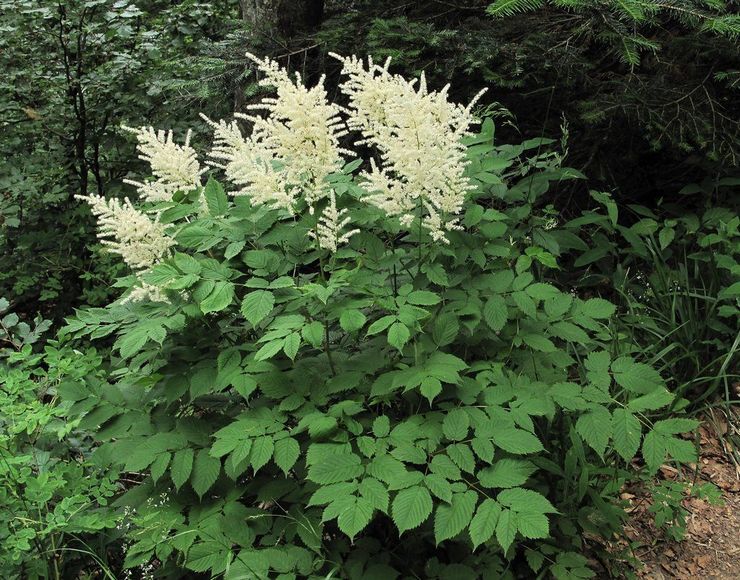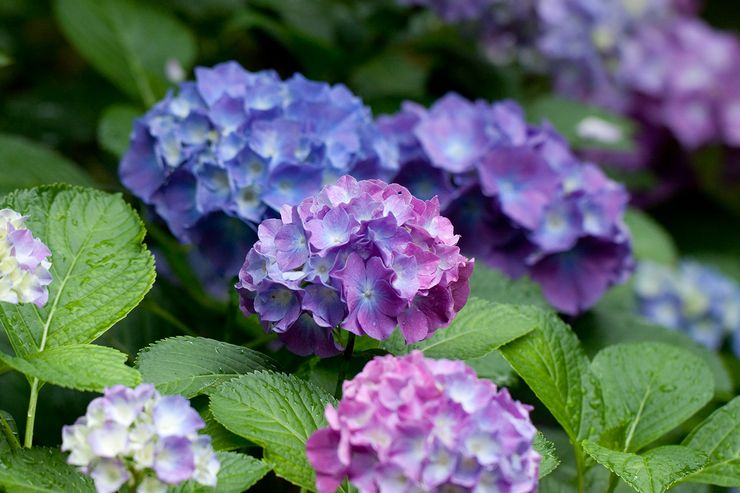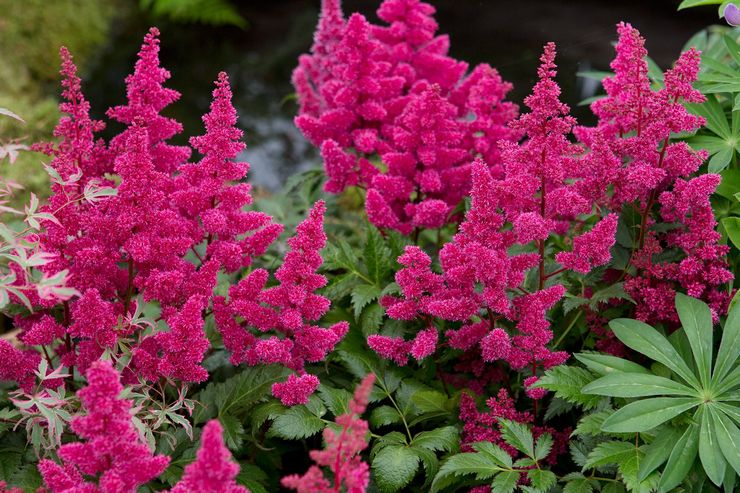
Many garden areas have shady corners where little sunlight gets in. Such an arrangement often creates problems when landscaping a garden – after all, most of the cultivated plants prefer bright or at least moderate sun. But, although it really won’t be possible to decorate such a corner with luxuriantly blooming species, there are many perennial shade-loving plants for the garden that can withstand well different degrees of shading..
Features of shade-loving plants

Before going for seeds or seedlings of shade-tolerant plants for a shady place in the garden, you should evaluate its characteristics. Direct rays can hit there for at least several hours a day, or not at all. Depending on this, you can make the final choice in favor of shade-tolerant or shade-loving plantings. The latter prefer shaded corners: in the sun, their development will be much worse..
Among shade-loving crops, there are both shrubs and flowers and grasses of various sizes. Such plants will perfectly fit into the garden, where there are many trees or shrubs, as well as buildings that create additional shade. Shading is considered vital for them, and in nature, many such plants live precisely under the canopy of the forest. Such features of growth form their characteristic appearance. Most often, shade is preferred by species with large and smooth foliage that can capture more light. At the same time, light-loving plants often have textured leaf blades. The roots of shade-loving species are strong and developed, but not very deep. This feature sometimes allows them to be grown in the near-trunk circles of garden trees or shrubs..
What to Plant in the Shadow &# 127802; Most Shade-loving Plants &# 127800;
Types of shade-loving perennial plants
Among shade-tolerant plants, perennials attract particular attention, creating a minimum of worries for the gardener. Such species include both ornamental shrubs suitable for solo planting or hedging, as well as flower and herbaceous crops. Their height is often not too high, which allows you to create various compositions from them or use them as compact landscape accents..
Among the perennials that can grow in the shade, the following species are often grown in the garden:
Shrubs
Astilba

A common plant that has many different varieties. Astilbe bushes for about a month delight the eye with spectacular multi-colored and fluffy panicles of inflorescences. Their color includes shades of pink, red, purple and white. The bushes are very decorative even without flowers – their delicate foliage and reddish twigs look good throughout the season..
Astilbe thrives best in partial shade, but will need to maintain soil moisture. On poor arid soils, the shrub will not last long, so it should be watered more often, and also fed regularly. But the timing of the appearance of buds and the peculiarities of the location of astilba on the site may depend on the specific species and variety. So plants of early or late flowering are able to grow both in the shade and in the sun, and varieties with July flowering prefer shady places..
Volzhanka

Volzhanki form sprawling bushes, during the flowering period they are covered with lush light inflorescences of small flowers. The size of such a shrub reaches 2 m in height. Although Volzhanks are able to grow in both shady and sunny places, in the latter case, the rate of its growth slows down, and the number of inflorescences decreases. In addition, under the scorching rays, the rich green color of the foliage can turn yellowish. But the more shady the location of the Volzhanka bush is, the later its flowering will come..
In addition to beautiful inflorescences, the main advantage of the Volzhanka is its unpretentiousness. In one place without transplanting, it can grow for about 20 years, without requiring frequent feeding. Usually, such bushes are grown in places sheltered from the cold wind under a thin crown or not far from a reservoir..
Geichera

Heuchera bushes attract with their beautiful foliage. Its palette of shades is impressive – it includes shades of white, green, red, gray, brown and magenta. Plants are also capable of forming discreet, but quite attractive inflorescences..
The lush foliage of Heucher guarantees their decorative effect throughout the warm season. These plantings also do not require careful maintenance and are distinguished by good immunity to the effects of diseases and pests. Of all the varieties of geyher, the red-leaved ones are considered the most photophilous. In the shade, their color changes to green. Varieties and species with foliage of a different color grow well in the sparse shade of trees, as well as in the corners of the garden, which are only lit in the morning or evening. In the sun, these plants will require more moisture. Heycherella also retains shade tolerance – a spectacular hybrid of Heuchera with tiarella.
Hydrangea

A beautiful hydrangea can also grow in moderate shade. Best of all, its bushes develop, being lit only in the morning hours. Such rays will provide the plant with light, but will not allow its flowers to burn out. Lush flowering shrubs can beautify any area. During flowering, they are covered with large globular inflorescences of various shades. The color of the flowers of some varieties of hydrangeas can change during the development of the bud, and in the large-leaved species, depending on the composition of the soil. It is noteworthy that young seedlings tolerate shading better than adult bushes..
The size of a hydrangea bush is 1 to 3 m in height. There are also liana-like plants, whose shoots can reach a length of about 15 m. Among hydrangeas, there are both deciduous and evergreen plants, but almost all hydrangeas love warmth and high humidity, therefore they need winter shelter. The most frost-resistant species are considered to be those with shoots lumbering over the summer..
Japanese maple

Widespread in Japan and South Korea, the type of maple is very popular with landscape designers. This is due to the existence of miniature varieties of such a tree, the height of which reaches only 2 m. The slow growth of the maple is combined with the grace of its crown and the beauty of its foliage. From spring to autumn, it has a bright green color, and closer to cold weather it turns into red-purple hues. This maple is widely used both for landscaping Japanese-style gardens and for adding exotic notes to the usual landscape. A semi-shady place is best suited for such a plant – scorching rays can leave burn marks on its leaves, but such a plant should not be planted in a deep shade either..
Although the tree can coexist with many plants, it will need enough space for a spreading crown. Maple is thermophilic, so in cold regions it will need a mandatory shelter for the winter. Before the onset of cold weather, its near-trunk area is covered with a 10-centimeter layer of mulch, and the lower part of the trunk is also covered with spruce branches.
Herbs and flowers
Astilba

The sizes of astilba bushes can vary from 15 cm to 2 m, therefore, depending on the variety, this plant can serve as both a large shrub and a low component of a flower bed. In winter, astilbe shoots die off, and in spring new ones appear to replace them. These flowers also love moist soil. Low astilba also does not tolerate drought, so it should be watered regularly, making sure that the soil does not dry out. Any types of astilba go well with other shade-tolerant plantings, they can also decorate the coastal zone of garden ponds.
Coleus

Coleus is able to grow not only in a pot – such plants are also used to decorate garden beds. These are fast-growing perennials that are not too demanding on the degree of illumination. Small lilac flowers of Coleus are not particularly valuable, but their leaves can combine many different color shades, including yellow, red, pink and brown. Multi-colored patterns are often located on one leaf blade..
Coleus is not so much in love with the shadow as he is afraid of the scorching sun. Direct rays can leave burns on its foliage, but in deep shadow its color will become less bright. In the garden for such plantings, a slightly shady place is selected, where scattered rays fall. Coleus bushes will look especially good in group plantings – often plants with different foliage colors are selected for this.
Coleus also loves moist soil, but does not tolerate severe frosts. To preserve the bushes until the next season, they are most often planted in containers, and for the winter they are transferred to the house or cuttings to preserve the plants. The critical temperature for such landings is -10 degrees..
Forget-me-not

The usual garden flower – forget-me-not, also prefers shaded corners of the garden. Caring for such plantings is very simple: it is enough to provide them with periodic watering. The appearance of small (no more than 1 cm) blue or pink flowers with a yellow center occurs in May-June. Most species of this plant thrive best in semi-shaded areas, with about 3-6 hours of light per day. Forget-me-not bushes are often planted under garden trees, where their lush bushes merge into a solid carpet. Moderately nutritious soil is best suited for growing such flowers. On poor soil, the bushes will not be able to grow normally, and an excess of fertilizer will have a bad effect on their flowering.
Violet

A violet will also need a minimum of care. These flowers are distinguished by varied color of petals and rich green foliage. Most violets do not like intense heat, so they feel best in semi-shady corners with sufficiently moist and nutritious soil. Popular garden species include horned, tricolor and scented violets..
Hosta

Hosta belongs to the number of decorative foliage crops. Its large and fleshy leaf plates, collected in a basal rosette, can be colored in blue-green, white or yellow tones and are often variegated. Although the hosta bush itself is usually not too tall, the size of the peduncles with bell-shaped flowers can be up to 1 meter. But along with medium-sized hosts, there are both tiny hosts about 10-15 cm high, and impressive bushes more than 80 cm high.
One of the main conditions for growing hosts is moist soil. The bush may not tolerate complete drying out of the soil. The degree of acceptable shading is directly related to the color of the foliage. Variegated and vibrant leaves will need more sunlight, but shade in the midday heat. Varieties with dark or blue foliage are kept in moderate shade. In the bright sun or in a too shaded place, their color will become normal, green.
Iris

Irises are distinguished by a large number of species and varieties. The petals of their flowers can be painted in shades of blue, purple, white, red, yellow, orange and many other colors – after all, the name of such plants is translated as “rainbow”.
Irises can develop from bulbs or rhizomes, so some aspects of their cultivation depend on the species. Bulbous plants are sometimes combined into 3 separate genera.
Although many irises tolerate shade well, such plantings will be able to bloom only in corners where enough sun penetrates in the morning. These flowers are drought-resistant and need watering only during bud formation. The only exceptions are certain species – for example, marsh iris, which prefers to grow on the banks of reservoirs, including in shallow water. Siberian iris also loves moisture – it is this type of plant that is considered the most shade-tolerant.
How to choose shade-loving plants for the garden

To better understand exactly how much light is needed for certain plants for normal development, you can use the following classification:
- Shadow – places illuminated by the sun only 2-3 hours a day;
- Sparse shadow – areas under trees with an openwork crown, through which a sufficient amount of sunlight penetrates. Many garden flowers can grow in such conditions;
- Penumbra – corners lit for about 3-4 hours – most often in the morning or in the evenings;
- Deep shadow – completely shaded places where the sun hardly penetrates. These are usually areas that are enclosed by building walls or fences. In such conditions, only a few species grow normally..
Guided by these definitions, you can understand which plants are suitable for decorating a certain part of the garden area. As with growing home flowers, the side of the world must also be taken into account when landscaping a garden. The northern direction is considered the most shady and wettest. If this place is also poorly lit due to tall trees, fences or buildings, only the most shade-loving plants, for example, ferns, will be able to grow there..
The creation of flower beds in the shade involves the observance of the general rules for the placement of plantings. Species that will grow together should not clash over nutrients or oppress each other, and their growing conditions should be similar..
What to plant in the shade? The most spectacular plants!
Subtleties of care
Shade-tolerant and shade-loving plants are usually highly resistant to the development of diseases and pest attacks. If, due to a lack of light, other flowers or shrubs become depressed, these species, on the contrary, only in such conditions will be able to manifest themselves in all their glory. Many of these plantings tolerate temperature fluctuations, but may be sensitive to insufficient soil moisture. It is especially important to keep an eye on her in late spring if there is little rain during this period. In severe drought, watering can be carried out several times a day. But the earth in the shade dries out a little more slowly, so it is not worth overmoistening it too much. Excessive moisture can lead to decay or disease, even for those who like shady places. To further protect plants, you should take care of good drainage, and also do not plant such crops in places with high groundwater levels..
To preserve the decorativeness of foliage and flowers, timely feeding plays an important role. They are selected depending on the preferences of a particular species. In addition to the introduction of nutrients and regular watering, the soil near the bushes should be carefully loosened and cleaned of weeds. This will improve oxygen access to the roots and help increase nutritional flow..
Shade-tolerant plants in landscape design

In the shady corners of the garden, you can create full-fledged flower beds – islands or mixborders. When composing plants, you need to maintain a sufficient distance between plantings so that the bushes or grasses are located reasonably tightly, but do not interfere with each other. On average, 1 sq. m can fit 7-10 low-growing ground cover plants, 5 medium bushes or 3 tall ones. The exact distance between plantings is determined in accordance with the requirements of a particular type and size of the bushes in width.
Moderately shaded vertical surfaces – walls or fences, can be decorated with shade-tolerant vines (clematis, girlish grapes), or shrubs with decorative foliage or flowers can be planted near them. The correct choice of shade-loving plants for each lighting zone will ennoble literally any corner of the garden.
